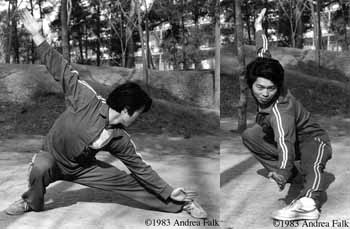Good post SPJ,
In point of fact I have been doing my own research on comparisons of various Shaolin postures extant that have their mirror in Yang Style specifically with slight variation ... we know that Yang Luchan and the Wu's were all well versed in Shaolin arts common in Yongnian before Yang had cause to travel to Chen village. We also know that the Chens had Shaolin Arts like Red Fist ( Hong Chuan ) and the Pao Chui ( Cannon Fist ) et al which are still practiced at Shaolin to this day.
For instance ... in Xintai Mei ( Plum Blossom Boxing ) and Shaolin generally we have a posture called Pu Bu or the Flat Stance. You will observe that this is essentially the same as Snake Creeps Down of Taijiquan with some small changes in flavour from style to style.
Image shows Pu Bu from Xintai Mei.

Here again we have postures from Xintai Mei ... look closely. The one on the left is obvious while the one on the right could be taken as a variation of "Stork Spreads Wings" or "Golden Cock Stands One Leg"

Here is another example of "Stork Spreads Wings" from Plum Blossom Boxing.

Here is some information about Plum Blossom Boxing which may be of great interest given the development of Yang Style and Yang Luchans synthesis of various arts in his invention of Taijiquan. My emphasis in bold.
According to records, Mei boxing was spread to Xingtai City of Hebei Province during the late Ming and early Qing dynasties. It Integrated the Eight Diagram of the Book of Changes into the boxing theory and the Five Elements of yin and yang into the movements, the boxing has been promoted and spread, and famous Mei boxing masters like Zhou Hong and Jing Tingbin have come forth.
The organization model of Mei boxing can be divided into two parts – literary and military, with the former leading the latter. The leading level of literary exercise gives emphasis on the research of theories which contain the essence of "Three Religions", responsible for the management of internal affairs of the boxing school; the pupils of the military exercise learn the boxing skills through the practice of martial arts. The level and form of the military practice can be divided into four parts, namely, posture, boxing forming, boxing wringing, and instruments. The movements of Mei boxing are unsophisticated and graceful, sturdy and powerful, so that they have not only appreciation value, but also practical function of striking and defending. Furthermore, both the guiding principle and movements follow the principles of "Five Elements" and "Eight Diagrams" in traditional Chinese culture which advocate "nurturing kungfu with literature, and aiding literature with kungfu", therefore, Mei boxing is also praised as "civil boxing".
Following the principle of "love the country and love the people", Xingtai Mei boxing has been spreading around Guangzong and Pingxiang for over 300 years. It has a clear master-pupil relation, and the practice has been handed down to the seventh generation with an extant Mei boxing chart. Generally, the master teaches the boxing skills by verbal instruction and personal example. Other than body-building effects, the practice of Mei boxing can also enrich the cultural life of the general public, and inspire the national spirit as well.
Things like this only serve to broaden ones view of the origins of Taijiquan both conceptually and historically - when taken into context with the many arts that already surrounded and pre-dated it' ... it seems that it was not something that just formed itself 'ex nihlo' but was rather far more heavily influenced by many commonly practiced arts of it's time.







